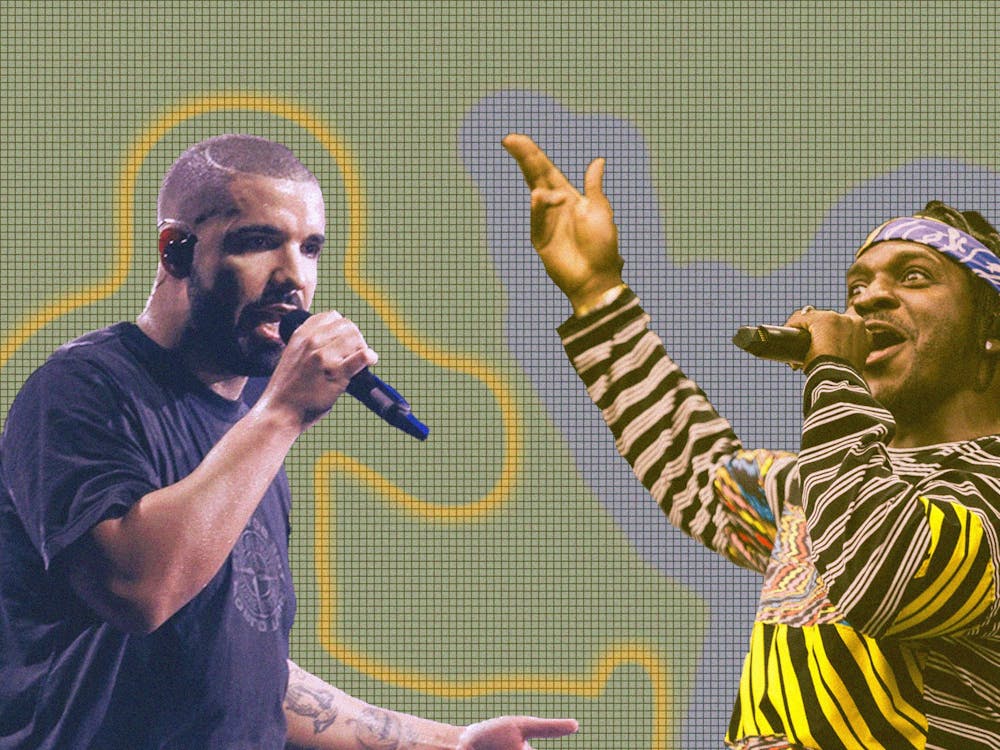In January 2018, Migos dropped all 106 minutes of “Culture II.” The new album lacked the hazy sincerity that elevated its predecessor to classic status. In its place was ceaseless bragging. Bloated tracks piled on top of each other like bodies during the Black Plague, and rap fans began to realize how insufferable “filler” albums are. This inflamed an ongoing debate over proper album length. It is a brutal war between laborious brevity and commercial indulgence.
It turns out that humans have an evolutionary fear of decisions. When presented with a few options, the right choice is often obvious. Staring at that blank search bar, however — with the power to demand any one of the billions of albums produced by humans — is terrifying. Expanding musical taste is often too daunting a task for casual listeners, so they turn to what is popular, or relapse on what they know they like.
Titans, most notably Drake, began to exploit the weakness of the streaming model. Artists are no longer paid by album sale but by individual stream, so adding filler tracks gives the listener more to explore. Even if these songs perform poorly, the streams they do acquire make the artist money, and often tons of it.
Kanye West’s first two albums, though fantastic, were overly long. However, he subtly took the mantle of Brevity General, and began to slowly trim the fat from his albums. In 2013, he released “Yeezus.” Clocking in at 10 tracks in 40 minutes, Yeezus was lean and razor sharp. It showed the power of focus and fully exploring a specific sonic theme.
Around the same time, Thebe Kgositsile (better known as Earl Sweatshirt) was released from his Samoan prison. He was no longer the ghoulish character he emerged as. He transitioned into rap’s most prolific recluse, which is perhaps proven most effectively by merely stating the title of his second studio album: “I Don’t Like Shit, I Don’t Go Outside.” His albums grew shorter, more densely packed. He is the Admiral, guarding the murky territory of rap, out of sight until the torpedo is too close to dodge.
Two major lieutenants who fly the flag of musical economy are Pusha T and Frank Ocean. Pusha T has dropped a mere 100 minutes of music in the past eight years (compared to Future’s 759), with skeleton projects that cut to the absolute core of his “Black Scarface” persona. Frank Ocean projects are, admittedly, long. But he starves his audience, making them wait years for even a single. He is a meticulous artist, who spends vast amounts of time perfecting his craft. This commitment to quality diminishes his output, which places him on the side of concision.
In the middle of the 2010s, the Commercial Battalion was gaining ground and the newly formed Innovation Militia was failing to disrupt their success. Drake became the undisputed streaming king. Future shaped the next 10 years of rap in his image. Kanye reverted to his old ways and released a 20-track album that flowed like concrete. BROCKHAMPTON released 47 songs in three months, which was actually praised by the rap community. Had they kept their momentum, the war would have been won with ease.
In 2018, the world changed. After seeing the pushback against the colossal “Culture II,” the Curt Comrades unleashed an ungodly assault, starting May 25 when Pusha T released “DAYTONA.” Not only does it serve as a showcase of the magnificent power of short albums (7 songs, 21 minutes), its final cut “Infrared” calls out Drake for relying on ghostwriters and hooks. Drake took the bait and sent back a stock diss track. Four days after releasing his album, Pusha T released the most toxic song in history, “The Story of Adidon,” which exposed Drake’s secret child Adonis to the world. It was murder in the first degree.
Kanye was, naturally, behind the whole thing (he produced all of “DAYTONA” and most likely informed Pusha T of Adonis’s existence), and he had only just begun. On June 1, he released his album “ye.” A week later, he released “KIDS SEE GHOSTS,” his collaboration with Kid Cudi. Another week passed, and Nas — perhaps the most technically skilled rapper alive — released an album produced by Kanye. All three of these albums have exactly seven songs in them. Along with “DAYTONA,” West organized and released 93 minutes of top-tier rap music over four albums. Drake’s single 2018 album, “Scorpion,” was 90 minutes long.
Then, Kanye started mentally dissociating and dropped off the map, only to emerge a year later as a missionary. But the cause was taken up by Earl and Tierra Whack, the new faces of compact music. Both of their 2018 albums were realizations of genre-shaking potential. Earl’s “Some Rap Songs” is genuinely the most economical album of the decade. The contents of that 24-minute album could have been broken up into three careers. Tierra Whack released “Whack World,” a 15-song album that runs only 15 minutes, with a perfect 1:1 split for every song. Each track ends in the middle of some apparently longer one, cut down to fit the structure.
While a correlation is impossible to prove, the commercial monopolists do seem to have been shaken. Drake is only a few weeks away from not releasing a project in 2019, which would make this the first year since 2014 without one. Both he and Future have released old classics instead of new material, and Future’s most recent release was only seven tracks long. While this war may not affect their pockets yet, it seems as though they are no longer fighting on level ground: They are being hunted.
Get The Chronicle straight to your inbox
Signup for our weekly newsletter. Cancel at any time.

